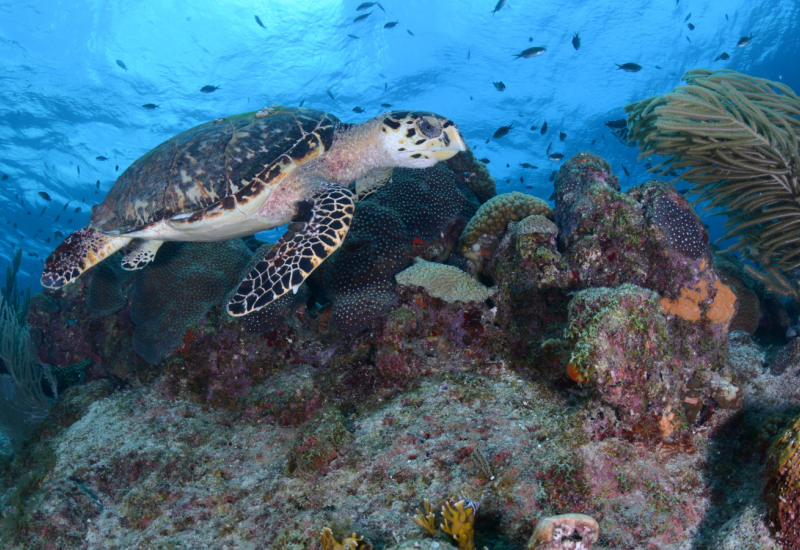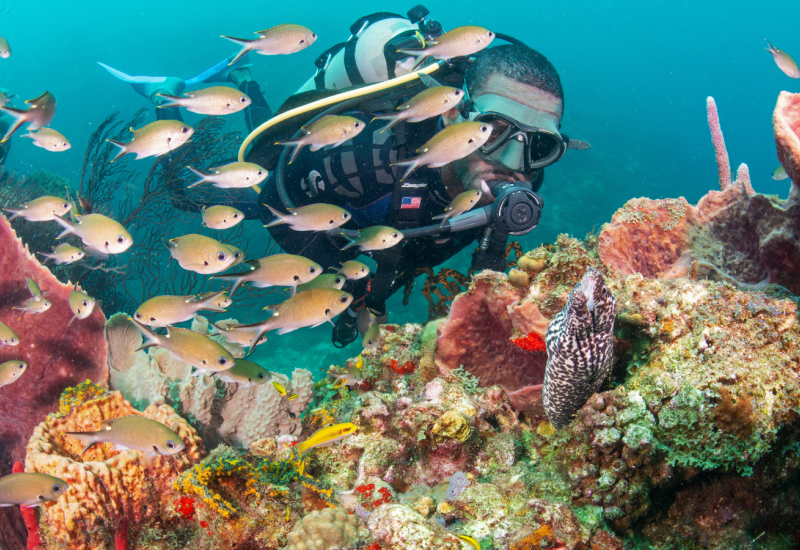Diving Papua New Guinea from the M/V Chertan Liveaboard
All Creatures Great and Small
I drift downward through a kaleidoscope of dancing sun rays on a sight known as Deacon’s, in the very heart of Milne Bay. Their convergence pulls me past a dramatic cavernlike overhang in the wall to a riot of color on the reef below. Omnipresent anthias surge and twitch in an electric tangerine current that flows around huge sea fans in hues of honey, lychee and mangosteen. This is truly a tropical marine cornucopia, I think as I spot fire gobies, butterflyfish, angelfish and an almost invisible crocodilefish. Juvenile emperor angels dazzle, rotund frogfish amuse, lionfish bewitch. Every moment is an opportunity to discover something amazing, and I am determined to indulge myself to the point of photographic gluttony.
As if on cue, our dive guide, Junior, proudly directs my camera toward some invisible wonder. I look through my viewfinder and see ... nothing. Junior grins and urges a second attempt. Then I spot it. Junior has found what is quite possibly the tiniest Severn’s pygmy seahorse on the planet. It doesn’t seem real. Two quick shots and I lose it again, but my gauges tell me it’s time to go. Just another dive in one of the most remarkable regions on Earth.
I am an Indo-Pacific-dive addict. I will have my bags packed faster than you can say Coral Triangle for almost any opportunity to travel to the region. You can count on great diving and interesting marine creatures there — that’s a given. But for that true feeling of adventure, it’s hard to beat the exotic wonders of Papua New Guinea.
Where it all Began
Milne Bay is situated on the eastern edge of PNG, between a confluence of nutrient-rich currents from the Coral and Solomon seas. For most divers, the adventure begins in Alotau. Here I was met by Rob Van der Loos, owner of M/V Chertan, who is one of the pioneers of Milne Bay diving and has lived more adventures than most of us have seen at the movies. A chance to hang out with him while we gather provisions in the backstreets and markets of Alotau is a perfect way to shift into a local pace, and perhaps bargain for crafts.
Although off the radar of many travelers, the Milne Bay region is legendary among divers, marine naturalists and photographers. “There is everything here for everyone,” says Roger Steene, an accomplished photographer and author of multiple fish ID books who makes frequent trips on Chertan.
This purpose-built liveaboard began operations out of Alotau more than 16 years ago. The vessel is manned by a full complement of qualified crew (usually five), which includes some of the best critter spotters available in the business. With a max of 10 divers, guests feel like the privileged few they are — every site is a private dive.
Most divers don’t realize that muck diving originated in PNG. Over the years, Van der Loos and his team have become muck aficionados, finding numerous rare, new nudibranch species to add to the wild, weird and wonderful creatures already discovered in New Guinea.
Knowing we are chomping at the bit, Van der Loos wastes no time backing up Chertan nearly to shore, tying the stern to the trees. “This little pocket of paradise is known as Lauadi,” he says. “There’s an incredible muck dive directly under the boat called Dinah’s Beach. The pool is open.”
Dinah’s is a classic black-sand muck dive, meaning you immediately find yourself on a very dark bottom in 25 feet of water looking at an apparent wasteland. But patience is rewarded, especially if you stick like glue to your guide as I did. It would take a few dives to develop my own muck vision, but Dinah’s Beach is an excellent training ground. Highlights on a single dive: finding a juvenile warty frogfish, emperor shrimp on a sea cucumber, peacock mantis shrimp, flabellina nudibranchs and jewel-like bobtail squid. The top prize has to be finding the rare and elusive Milne Bay epaulette shark on a night dive on the same site. These small, elegantly marked carpet sharks are rarely seen by day.
Back on board we are regularly plied with tea and cookies. The obsessive photographers in the group, myself included, sip the tea and grease O-rings on the large table on the upper deck. The view of verdant, jungle-covered shorelines while downloading SD cards only adds to the wonderment.
Hooked on a Feeling
The week progresses in spite of my best efforts to stop the clocks. I am bedazzled by the bommielike reef on Tania’s that rises close enough that my safety stop encircles the shallows and almost requires the dive guides to drag me back to the boat. I swoon at the mantas that circle the bommie at Gona Bara Bara as they hover, nearly motionless, while wrasse eagerly go about cleaning them.
My time was almost over. I had long heard stories of orcas occasionally showing up at Wahoo Point. They have appeared twice — not exactly a pattern, but orcas are on my bucket list, and I have come close to seeing them in northern PNG before. Surely it was worth a try. Seeing eagle rays and a few sharks parade along the wall as we descend seems promising, and the topography is stunning. I focus on the blue and project my best orca vibe — whatever that is, but I try.
I also try not to be distracted by the big schools of fish and a brief pass by a manta, but the place is easy to get lost in. I’m on a mission. When another guide, Seba, tries to show me an elaborate scorpionfish, I shoo him away too quickly, as my computer makes clear a moment later. My safety stop allows me to turn slow 360s, and I let the dance of light and waves play tricks on my imagination. I take one last look over my shoulder before leaving the water, but there would be no orca that day. Instead, I got another spectacular dive experience in Milne Bay — and another reason to come back.
FIVE REASONS TO DIVE MILNE BAY ABOARD CHERTAN
1. Comfortable Cabins
Chertan has five comfortable double-bunk cabins, each with its own sink and storage space. All accommodations are air-conditioned.
2. Dive Guides Seba and Junior
Are you looking for particular critters? Odds are good these locals can find them for you.
3. Expert Advice
Owner Rob Van der Loos has been capturing images of marine life in the region for 35 years.
4. Sumptuous Home-Style Cooking
Fresh local fruits are just the beginning — you might need to loosen your BC!
5. Fewer Divers
Chertan can accommodate 10 guests, but it will run with six.
NEED TO KNOW
When To Go Year-round, with the exception of February, when dive sites might be off-limits because of strong westerlies.
Dive Conditions Water temperatures in summer months can be as high as 84 degrees, and in winter as low as 77 degrees. During the wet season, visibility increases substantially due to the prevailing currents. Even though the wet season lasts for only two to three months, the visibility generally remains high from June to October. November through May, though the visibility drops, seems to offer a different variety of macro subjects.
Operator M/V Chertan (chertan.com). There are five deluxe cabins — all with private bathrooms — for a maximum of 10 passengers.
Price Tag As we went to press, a 10-night charter to Milne Bay with up to four dives per day ran roughly $3,300 per person.

Tanya G. BurnettHordes of orange anthias and candy-colored coral greet divers at Tania's Reef in PNG.
All Creatures Great and Small
I drift downward through a kaleidoscope of dancing sun rays on a sight known as Deacon’s, in the very heart of Milne Bay. Their convergence pulls me past a dramatic cavernlike overhang in the wall to a riot of color on the reef below. Omnipresent anthias surge and twitch in an electric tangerine current that flows around huge sea fans in hues of honey, lychee and mangosteen. This is truly a tropical marine cornucopia, I think as I spot fire gobies, butterflyfish, angelfish and an almost invisible crocodilefish. Juvenile emperor angels dazzle, rotund frogfish amuse, lionfish bewitch. Every moment is an opportunity to discover something amazing, and I am determined to indulge myself to the point of photographic gluttony.

Tanya G. BurnettA clown anemonefish nestles in a purple anemone off the Samurai Wharf in Milne Bay, PNG.
As if on cue, our dive guide, Junior, proudly directs my camera toward some invisible wonder. I look through my viewfinder and see ... nothing. Junior grins and urges a second attempt. Then I spot it. Junior has found what is quite possibly the tiniest Severn’s pygmy seahorse on the planet. It doesn’t seem real. Two quick shots and I lose it again, but my gauges tell me it’s time to go. Just another dive in one of the most remarkable regions on Earth.

Tanya G. BurnettVibrantly colored tube anemones light up the reef in Papua New Guinea.
I am an Indo-Pacific-dive addict. I will have my bags packed faster than you can say Coral Triangle for almost any opportunity to travel to the region. You can count on great diving and interesting marine creatures there — that’s a given. But for that true feeling of adventure, it’s hard to beat the exotic wonders of Papua New Guinea.

Tanya G. BurnettThe rare and beautiful donut Doto nudibranch can be spotted during muck dives in PNG.
Where it all Began
Milne Bay is situated on the eastern edge of PNG, between a confluence of nutrient-rich currents from the Coral and Solomon seas. For most divers, the adventure begins in Alotau. Here I was met by Rob Van der Loos, owner of M/V Chertan, who is one of the pioneers of Milne Bay diving and has lived more adventures than most of us have seen at the movies. A chance to hang out with him while we gather provisions in the backstreets and markets of Alotau is a perfect way to shift into a local pace, and perhaps bargain for crafts.

Tanya G. BurnettDiving from Chertan, divers with a careful eye — or a really good dive guide — will find incredible marine life, like this camouflaged crocodilefish.
Although off the radar of many travelers, the Milne Bay region is legendary among divers, marine naturalists and photographers. “There is everything here for everyone,” says Roger Steene, an accomplished photographer and author of multiple fish ID books who makes frequent trips on Chertan.
This purpose-built liveaboard began operations out of Alotau more than 16 years ago. The vessel is manned by a full complement of qualified crew (usually five), which includes some of the best critter spotters available in the business. With a max of 10 divers, guests feel like the privileged few they are — every site is a private dive.
Most divers don’t realize that muck diving originated in PNG. Over the years, Van der Loos and his team have become muck aficionados, finding numerous rare, new nudibranch species to add to the wild, weird and wonderful creatures already discovered in New Guinea.

Tanya G. BurnettM/V Chertan has five deluxe cabins — all with private bathrooms — for a maximum of 10 passengers.
Knowing we are chomping at the bit, Van der Loos wastes no time backing up Chertan nearly to shore, tying the stern to the trees. “This little pocket of paradise is known as Lauadi,” he says. “There’s an incredible muck dive directly under the boat called Dinah’s Beach. The pool is open.”
Dinah’s is a classic black-sand muck dive, meaning you immediately find yourself on a very dark bottom in 25 feet of water looking at an apparent wasteland. But patience is rewarded, especially if you stick like glue to your guide as I did. It would take a few dives to develop my own muck vision, but Dinah’s Beach is an excellent training ground. Highlights on a single dive: finding a juvenile warty frogfish, emperor shrimp on a sea cucumber, peacock mantis shrimp, flabellina nudibranchs and jewel-like bobtail squid. The top prize has to be finding the rare and elusive Milne Bay epaulette shark on a night dive on the same site. These small, elegantly marked carpet sharks are rarely seen by day.
Back on board we are regularly plied with tea and cookies. The obsessive photographers in the group, myself included, sip the tea and grease O-rings on the large table on the upper deck. The view of verdant, jungle-covered shorelines while downloading SD cards only adds to the wonderment.
Hooked on a Feeling
The week progresses in spite of my best efforts to stop the clocks. I am bedazzled by the bommielike reef on Tania’s that rises close enough that my safety stop encircles the shallows and almost requires the dive guides to drag me back to the boat. I swoon at the mantas that circle the bommie at Gona Bara Bara as they hover, nearly motionless, while wrasse eagerly go about cleaning them.
My time was almost over. I had long heard stories of orcas occasionally showing up at Wahoo Point. They have appeared twice — not exactly a pattern, but orcas are on my bucket list, and I have come close to seeing them in northern PNG before. Surely it was worth a try. Seeing eagle rays and a few sharks parade along the wall as we descend seems promising, and the topography is stunning. I focus on the blue and project my best orca vibe — whatever that is, but I try.
I also try not to be distracted by the big schools of fish and a brief pass by a manta, but the place is easy to get lost in. I’m on a mission. When another guide, Seba, tries to show me an elaborate scorpionfish, I shoo him away too quickly, as my computer makes clear a moment later. My safety stop allows me to turn slow 360s, and I let the dance of light and waves play tricks on my imagination. I take one last look over my shoulder before leaving the water, but there would be no orca that day. Instead, I got another spectacular dive experience in Milne Bay — and another reason to come back.
FIVE REASONS TO DIVE MILNE BAY ABOARD CHERTAN
1. Comfortable Cabins Chertan has five comfortable double-bunk cabins, each with its own sink and storage space. All accommodations are air-conditioned.
2. Dive Guides Seba and Junior Are you looking for particular critters? Odds are good these locals can find them for you.
3. Expert Advice Owner Rob Van der Loos has been capturing images of marine life in the region for 35 years.
4. Sumptuous Home-Style Cooking Fresh local fruits are just the beginning — you might need to loosen your BC!
5. Fewer Divers Chertan can accommodate 10 guests, but it will run with six.
NEED TO KNOW
When To Go Year-round, with the exception of February, when dive sites might be off-limits because of strong westerlies.
Dive Conditions Water temperatures in summer months can be as high as 84 degrees, and in winter as low as 77 degrees. During the wet season, visibility increases substantially due to the prevailing currents. Even though the wet season lasts for only two to three months, the visibility generally remains high from June to October. November through May, though the visibility drops, seems to offer a different variety of macro subjects.
Operator M/V Chertan (chertan.com). There are five deluxe cabins — all with private bathrooms — for a maximum of 10 passengers.
Price Tag As we went to press, a 10-night charter to Milne Bay with up to four dives per day ran roughly $3,300 per person.










